
 1
1








 1
1




 9
9




 1
1




 3
3




 1
1












 3
3




 5
5




 5
5




 5
5




 2
2




 1
1








 2
2








 4
4




 4
4




 2
2




 3
3




 2
2










 4
4




 2
2








 3
3




 5
5




 1
1








Konstantinos Karoubas wrote:Definitely Anton,
I think at higher elevations they will thrive, as will chestnuts.
I have ordered some pecans to try this year around here...they say they are more drought resistant.
They have not shown up yet.
I strongly believe that every piece of land has a few trees, shrubs and grasses that it loves to grow...and will grow them easily, abundantly and without any assistance or care.
By offering a large variety of seeds and observing wild nature nearby, the secrets of the land will be revealed, and then farming and reforestation will be effortless.
The land and all of its creatures will rejoice !!!
(lol)
Kostas
 2
2








 1
1




Konstantinos Karoubas wrote:Antonio,
I forgot to mention,
Mark some of the locations you place the seeds, so you can check on them.
You can put three stones, or a stick to mark the location.
In the spring, as the weeds grow its tough to find the small new trees.
Kostas




 2
2




 2
2





 1
1





|
"I know this defies the law of gravity... but I never studied law." -B. Bunny Defiant tiny ad:
The new gardening playing cards kickstarter is now live!
https://www.kickstarter.com/projects/paulwheaton/garden-cards
|








